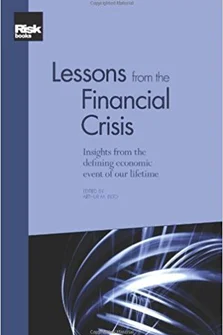Forecasting Extreme Risk of Equity Portfolios with Fundamental Factors
Vladislav Dubikovsky, Michael Y Hayes, Lisa R Goldberg and Ming Liu
Introduction to 'Lessons from the Financial Crisis'
The Credit Crunch of 2007: What Went Wrong? Why? What Lessons Can be Learned?
Underwriting versus Economy: A New Approach to Decomposing Mortgage Losses
The Shadow Banking System and Hyman Minsky’s Economic Journey
The Collapse of the Icelandic Banking System
The Quant Crunch Experience and the Future of Quantitative Investing
No Margin for Error: The Impact of the Credit Crisis on Derivatives Markets
The Re-Emergence of Distressed Exchanges in Corporate Restructurings
Modelling Systemic and Sovereign Risks
Measuring and Managing Risk in Innovative Financial Instruments
Forecasting Extreme Risk of Equity Portfolios with Fundamental Factors
Limits of Implied Credit Correlation Metrics Before and During the Crisis
Another view on the pricing of MBSs, CMOs and CDOs of ABS
Pricing of Credit Derivatives with and without Counterparty and Collateral Adjustments
A Practical Guide to Monte Carlo CVA
The Endogenous Dynamics of Markets: Price Impact, Feedback Loops and Instabilities
Market Panics: Correlation Dynamics, Dispersion and Tails
Financial Complexity and Systemic Stability in Trading Markets
The Martingale Theory of Bubbles: Implications for the Valuation of Derivatives and Detecting Bubbles
Managing through a Crisis: Practical Insights and Lessons Learned for Quantitatively Managed Equity Portfolios
Active Risk Management: A Credit Investor’s Perspective
Investment Strategy Returns: Volatility, Asymmetry, Fat Tails and the Nature of Alpha
Extreme events are an important source of financial risk, but they present special challenges in quantitative forecasting. This chapter describes an empirical approach to forecasting extreme risk and evaluates its accuracy out-of-sample on a range of factor-based strategies and pair trades. The results show that for a large majority of strategies the empirical model is more consistent with market behaviour than a conditional normal model.
Like volatility, shortfall comes equipped with a standard portfolio management toolkit that includes risk budgets, betas and correlations (Goldberg et al 2010). Shortfall optimisation can be formulated as a linear programming problem, and it is therefore a suitable risk measure for portfolio construction, as described in Rockafellar and Uryasev (2000, 2002) and Bertsimas et al (2004). This optimisation framework has been applied in Bender et al (2010) as a constraint in the active management context, and for asset allocation in Sheikh and Qiao (2009). On the other hand, important questions remain about the practical application of shortfall in the investment process. One question is the role of estimation error, which has been studied
Copyright Infopro Digital Limited. All rights reserved.
As outlined in our terms and conditions, https://www.infopro-digital.com/terms-and-conditions/subscriptions/ (point 2.4), printing is limited to a single copy.
If you would like to purchase additional rights please email info@risk.net
Copyright Infopro Digital Limited. All rights reserved.
You may share this content using our article tools. As outlined in our terms and conditions, https://www.infopro-digital.com/terms-and-conditions/subscriptions/ (clause 2.4), an Authorised User may only make one copy of the materials for their own personal use. You must also comply with the restrictions in clause 2.5.
If you would like to purchase additional rights please email info@risk.net










